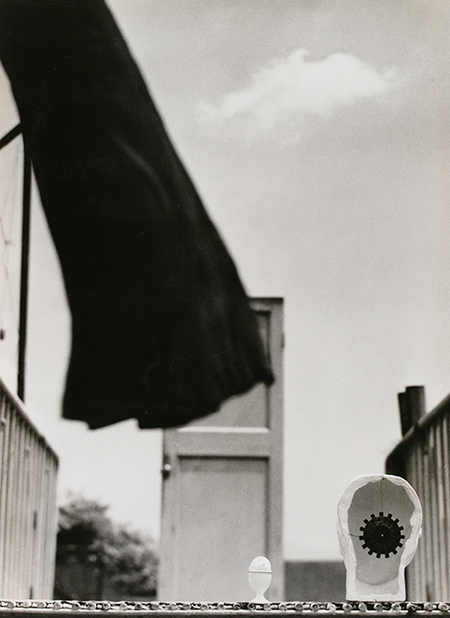
Hirai Terushichi "Wind" 1938, Collection of Tokyo Photographic Art Museum
The Tokyo Photographic Art Museum will adhere to relevant guidelines and take necessary measures to prevent the spread of the novel coronavirus. We ask for your understanding regarding inconveniences for this time. [Notices to Visitors]
3F
Avant-Garde Rising
The Photographic Vanguard in Modern Japan
May. 20—Aug. 21, 2022
- May. 20—Aug. 21, 2022
- Closed Mondays (except when Monday falls on a holiday, in which case the museum is open and closed the following day)
- Admission:Adults ¥700(560) / College Students¥560(440) / High School and Junior High School Students, Over 65¥350(280) *The prices in parentheses ( ) are discounted prices for holders of our movie tickets, and various card members. Please refer to Visitor Information for details on our discounts. Discounts cannot be combined with other discounts. *Admission is free for children in elementary school or younger; junior high school students living or attending schools in the Tokyo metropolitan area; holders of Japanese disability identification cards (shogaisha techo), along with up to two caregivers; and holders of the museum’s annual passport.
It is recommended that you use the online ticket system (timed entry reservation.)

Click here for online ticket system: Webket
Exhibition Summary
In the history of photography in modern Japan, avant-garde photography was a movement influenced by the Surrealist and Abstract art introduced from abroad that flourished in amateur photography groups nationwide in the 1930s and 1940s. Because the period in these photographers were actively presenting work was very short, there have been few close examinations of this movement. Recently, however, research has been progressing at museums throughout Japan, and a growing number of exhibitions overseas have been drawing attention to these works.
Until then, photography had been strongly influenced by painting, but avant-garde photography was not confined to painters. Poets and designers also participated, and this movement’s span grew. In particular, the International Surrealist Exhibition in 1937 put many photographers in contact with Surrealism and inspired them to work towards new forms of creative expression, while painters began using photographs in exploring styles not possible with painting alone. As wartime restrictions on the arts intensified, however, activities in each region were forced to come to an end.
While it was impossible for avant-garde photography to resist the tide of militarism, seeing these works overshadowed by war reminds us of the importance of freedom of expression, as well as the breadth of creativity made possible by photography.
Part 1: Impact―Contemporaneous Photographers Overseas
The Osaka-centered boom in avant-garde photography was inspired by contact with the work of contemporaneous photographers overseas, mainly through magazines and photobooks. Gravure pages and special sections on photographers overseas in photography magazines in Japan, including Photo Times (published by Photo Times-sha from 1924) and Asahi Camera (published by Asahi Shimbun from 1926), introduced the work of Eugene Atget and Man Ray. The photographs themselves were first shown in Japan at exhibitions rather than in magazines at the Internationale Ausstellung Film und Foto exhibition in 1931 and the International Surrealist Exhibition in 1937. Touring exhibitions, they were held in Osaka and other venues as well as Tokyo. Many photographers have written about those exhibitions’ impact on their work. In this exhibition, we introduce works published during this period by European photographers, selected from those in our museum’s collection.
[Artist]
MAN RAY, Eugène Atget, Hans Bellmer, Albert Renger-Patzsch, Cecil Beaton, BRASSAI
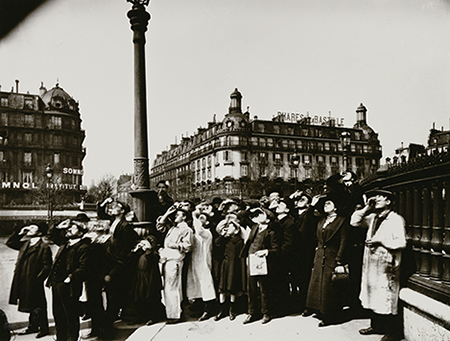
Eugène Atget "During a Solar Eclipse" 1912, Collection of Tokyo Photographic Art Museum
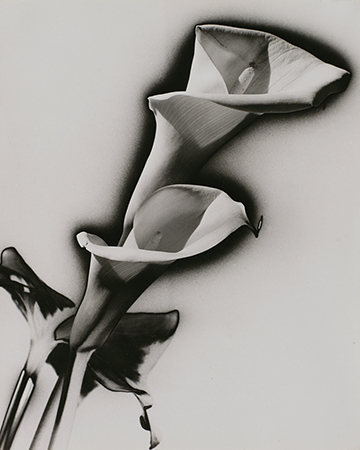
Man Ray "Calla Lilies" c.1930, Collection of Tokyo Photographic Art Museum
Part 2: Osaka
It is not going too far to say that avant-garde photography spread from the Kansai region to other parts of Japan. At the core of this movement were clubs formed by amateur photographers. The Naniwa Photography Club was founded in Osaka in 1904 and still exists today. The members who joined this club in the 1930s shifted away from Pictoralism, the style strongly influenced by painting that had been dominant until then, to Shinkō Shashin, the New Photography, influenced by new photography from Europe and the USA. In 1930, Ueda Bizan and Yasui Nakaji led a group that split off from the Naniwa Photography Club to form the Tampei Photography Club, which aimed at more progressive photography. That same year, Nakayama Iwata, who had returned to Japan from Europe and moved to Ashiya, near Kobe in the Kansai, was the central figure in founding the Ashiya Camera Club. Later, Hirai Terushichi and Honjo Koro, strongly influenced by the International Surrealist Exhibition in 1937, formed the Avant-Garde Image Group. The flourishing of these groups drew attention to the work of Kansai photographers as leaders of the avant-garde movement.
[Artist]
Nakayama Iwata, Murata Yonetaro, Yasui Nakaji, Kono Toru, Koishi Kiyoshi, Amano Ryuichi, Hirai Terushichi, Tarui Yoshio, Honjo Koro, Shiihara Osamu, Tabuchi Kaneyosih, Hattori Yoshibumi, Yano Toshinobu, Kobayashi Meison, Otono Sutezo, Hanaya Kanbee

Koshi Kiyoshi "Fatigue" from the series "Drunken Dream" 1936, Collection of Tokyo Photographic Art Museum
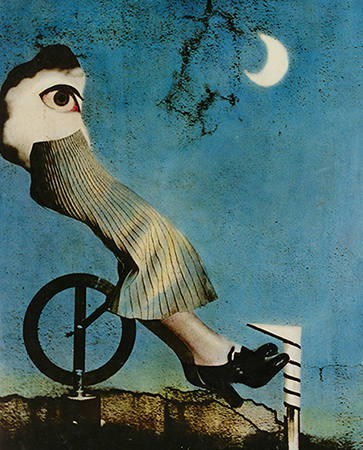
Hirai Terushichi, Fantasies of the Moon, 1938, Collection of Tokyo Photographic Art Museum
Part 3: Nagoya
Avant-garde photography in Nagoya was a collaboration involving critics and poets as well as photographers. These included the critic and poet Yamanaka Chiruu, who played a central role in introducing Surrealism to Japan. Yamanaka and the painter Shimozato Yoshio formed the Nagoya Avant-Garde Club, from which the photography section split off to form the Nagoya Photo Avant-Garde, in which the poet Yamamoto Kansuke participated. The leader of this group was Sakata Minoru, who, while living in Osaka, had been a member of the Naniwa Photography Club and in 1934 had led the formation of the Nagoya Photo Gruppe. In magazines like Camera Art (launched in 1935 by Camera Art Inc.) and Photo Times, these photographers developed and debated their theories of photography. Meanwhile, Camera, a coterie magazine published by amateur photographers in Nagoya (launched in 1936 by Cameraman Inc.) organized roundtable discussions to reexamine avant-garde photography. Its participants visited Fukuoka, where they influenced members of Sociêtê Irf.
[Artist]
Sakata Minoru, Tajima Tsuguo, Yamamoto Kansuke, Goto Keiishiro
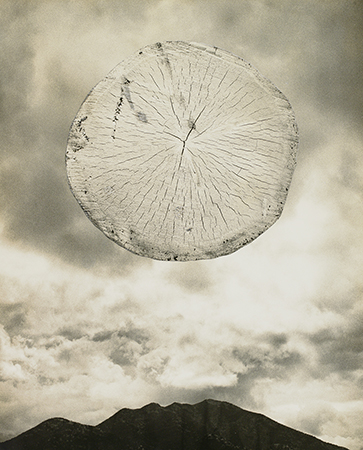
Goto Keiichiro, The Last Judgement, 1935-40, Collection of Tokyo Photographic Art Museum
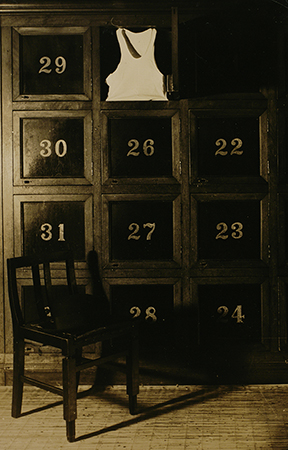
Yamamoto Kansuke, Title unknown (bathroom Shelf and chair), c1935, Collection of Tokyo Photographic Art Museum
Part 4: Fukuoka
Sociêtê Irf was an avant-garde art group active in Fukuoka from 1939 to 1940. The “Irf” in its name is furui, Japanese for “old,” written backwards. It explored and practiced “new” approaches to art, i.e., Surrealism and Abstraction. The seven core members were Takahashi Wataru, Tanaka Zentoku, Konomi Giichiro, Hisano Hisashi, and Yoshizaki Hitori (who joined later), who were members of a local amateur photographers group, Koike Iwataro, who later became a famous designer, and the painter Ito Kenshi. In contrast to other local groups, some of its members did not take up photography. Moreover, while this group was formed in 1939, later than the other avant-garde groups in other regions, its members had begun exhibiting their work in the late 1920s, participating in the Ashiya Photo Salon and the Kansai Photography Federation’s photo competitions. Ito showed his work in the Nika Exhibition. The creative activities of this group’s members was not confined to Fukuoka.
[Artist]
Takahashi Wataru, Hisano Hisashi, Konomi Giichiro, Tanaka Zentoku, Yoshizaki Hitori, Ito Kenshi
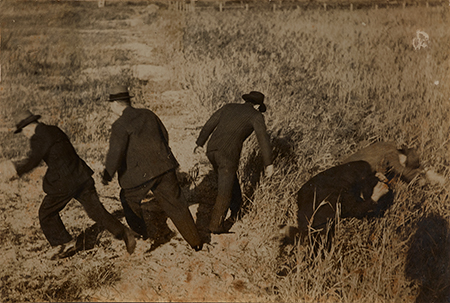
Photographer Unkown, IRF on the Run, 1939, Collection of Fukuoka Art Museum
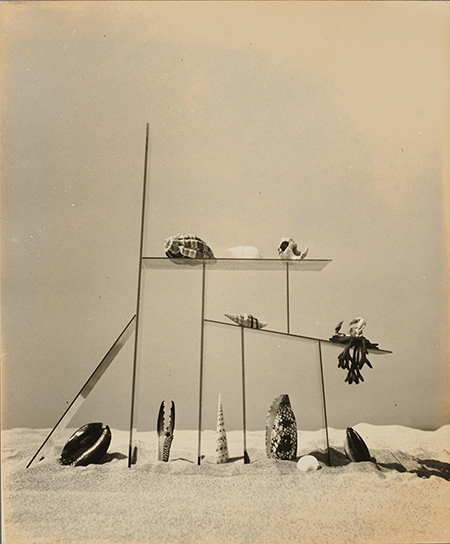
Hisano Hisashi, Display Window of Sea Life, 1938, Collection of Fukuoka Art Museum
Part 5: Tokyo
In Tokyo, the Avant-Garde Photography Association, founded in 1938 by Takiguchi Shuzo, Nagata Isshu, and Narahara Hiroshi with backing from Photo Times magazine, was the group most responsible for activities related to avant-garde photography. Its members also included the photographers Abe Yoshifumi (Nobuya), Imai Shigeru, Hamaya Hiroshi, Nishio Susumu, and Tanaka Masao, and several painters. Takiguchi contributed essays on avant-garde photography to Photo Times and other magazines and later wrote articles on photographer for several other magazines as well, becoming the association’s spiritual leader. At that time, the magazines with gravure pages that introduced avant-garde photographers used them more often to introduce painters. In them we can see the enthusiasm of painters searching for new forms of expression through photography. Besides the activities of the Ei-Q and Onchi Koshiro groups, those magazines also published avant-garde photography using the photogram and photomontage. Around the same time, the Seinen hodo shashin kenkyukai (Young Documentary Photo Research Club) was formed, also backed by the Photo Times, with members who included Domon Ken, Fujimoto Shihachi, and Hamaya Hiroshi. In 1941, however, Photo Times was forced by wartime magazine consolidation and elimination to change its name to Hodoshashin (Photo journalism). Avant-garde photography swiftly disappeared from its pages.
[Artist]
Nagata Isshu, Onchi Koshiro, Ei-Q, Hamaya Hiroshi
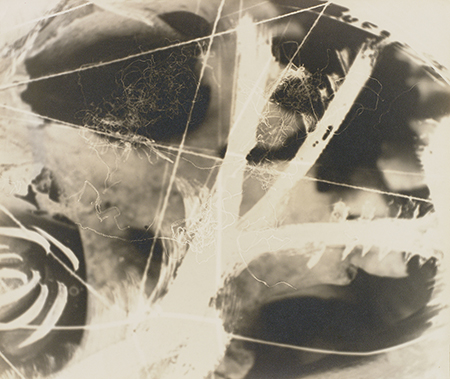
Ei-Q, From the series Photo Dessin, 1939, Collection of Tokyo Photographic Art Museum
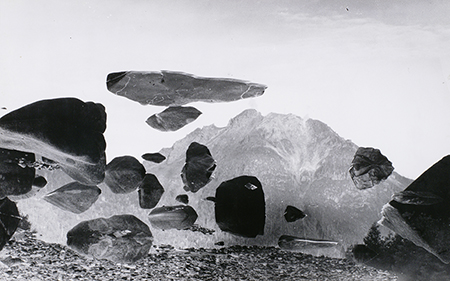
Nagata Isshu, Fire mountain, 1939, Collection of Tokyo Photographic Art Museum
Click here for online ticket system: Webket
Exhibition Summary
In the history of photography in modern Japan, avant-garde photography was a movement influenced by the Surrealist and Abstract art introduced from abroad that flourished in amateur photography groups nationwide in the 1930s and 1940s. Because the period in these photographers were actively presenting work was very short, there have been few close examinations of this movement. Recently, however, research has been progressing at museums throughout Japan, and a growing number of exhibitions overseas have been drawing attention to these works.
Until then, photography had been strongly influenced by painting, but avant-garde photography was not confined to painters. Poets and designers also participated, and this movement’s span grew. In particular, the International Surrealist Exhibition in 1937 put many photographers in contact with Surrealism and inspired them to work towards new forms of creative expression, while painters began using photographs in exploring styles not possible with painting alone. As wartime restrictions on the arts intensified, however, activities in each region were forced to come to an end.
While it was impossible for avant-garde photography to resist the tide of militarism, seeing these works overshadowed by war reminds us of the importance of freedom of expression, as well as the breadth of creativity made possible by photography.
Part 1: Impact―Contemporaneous Photographers Overseas
The Osaka-centered boom in avant-garde photography was inspired by contact with the work of contemporaneous photographers overseas, mainly through magazines and photobooks. Gravure pages and special sections on photographers overseas in photography magazines in Japan, including Photo Times (published by Photo Times-sha from 1924) and Asahi Camera (published by Asahi Shimbun from 1926), introduced the work of Eugene Atget and Man Ray. The photographs themselves were first shown in Japan at exhibitions rather than in magazines at the Internationale Ausstellung Film und Foto exhibition in 1931 and the International Surrealist Exhibition in 1937. Touring exhibitions, they were held in Osaka and other venues as well as Tokyo. Many photographers have written about those exhibitions’ impact on their work. In this exhibition, we introduce works published during this period by European photographers, selected from those in our museum’s collection.
[Artist]
MAN RAY, Eugène Atget, Hans Bellmer, Albert Renger-Patzsch, Cecil Beaton, BRASSAI

Eugène Atget "During a Solar Eclipse" 1912, Collection of Tokyo Photographic Art Museum

Man Ray "Calla Lilies" c.1930, Collection of Tokyo Photographic Art Museum
Part 2: Osaka
It is not going too far to say that avant-garde photography spread from the Kansai region to other parts of Japan. At the core of this movement were clubs formed by amateur photographers. The Naniwa Photography Club was founded in Osaka in 1904 and still exists today. The members who joined this club in the 1930s shifted away from Pictoralism, the style strongly influenced by painting that had been dominant until then, to Shinkō Shashin, the New Photography, influenced by new photography from Europe and the USA. In 1930, Ueda Bizan and Yasui Nakaji led a group that split off from the Naniwa Photography Club to form the Tampei Photography Club, which aimed at more progressive photography. That same year, Nakayama Iwata, who had returned to Japan from Europe and moved to Ashiya, near Kobe in the Kansai, was the central figure in founding the Ashiya Camera Club. Later, Hirai Terushichi and Honjo Koro, strongly influenced by the International Surrealist Exhibition in 1937, formed the Avant-Garde Image Group. The flourishing of these groups drew attention to the work of Kansai photographers as leaders of the avant-garde movement.
[Artist]
Nakayama Iwata, Murata Yonetaro, Yasui Nakaji, Kono Toru, Koishi Kiyoshi, Amano Ryuichi, Hirai Terushichi, Tarui Yoshio, Honjo Koro, Shiihara Osamu, Tabuchi Kaneyosih, Hattori Yoshibumi, Yano Toshinobu, Kobayashi Meison, Otono Sutezo, Hanaya Kanbee

Koshi Kiyoshi "Fatigue" from the series "Drunken Dream" 1936, Collection of Tokyo Photographic Art Museum

Hirai Terushichi, Fantasies of the Moon, 1938, Collection of Tokyo Photographic Art Museum
Part 3: Nagoya
Avant-garde photography in Nagoya was a collaboration involving critics and poets as well as photographers. These included the critic and poet Yamanaka Chiruu, who played a central role in introducing Surrealism to Japan. Yamanaka and the painter Shimozato Yoshio formed the Nagoya Avant-Garde Club, from which the photography section split off to form the Nagoya Photo Avant-Garde, in which the poet Yamamoto Kansuke participated. The leader of this group was Sakata Minoru, who, while living in Osaka, had been a member of the Naniwa Photography Club and in 1934 had led the formation of the Nagoya Photo Gruppe. In magazines like Camera Art (launched in 1935 by Camera Art Inc.) and Photo Times, these photographers developed and debated their theories of photography. Meanwhile, Camera, a coterie magazine published by amateur photographers in Nagoya (launched in 1936 by Cameraman Inc.) organized roundtable discussions to reexamine avant-garde photography. Its participants visited Fukuoka, where they influenced members of Sociêtê Irf.
[Artist]
Sakata Minoru, Tajima Tsuguo, Yamamoto Kansuke, Goto Keiishiro

Goto Keiichiro, The Last Judgement, 1935-40, Collection of Tokyo Photographic Art Museum

Yamamoto Kansuke, Title unknown (bathroom Shelf and chair), c1935, Collection of Tokyo Photographic Art Museum
Part 4: Fukuoka
Sociêtê Irf was an avant-garde art group active in Fukuoka from 1939 to 1940. The “Irf” in its name is furui, Japanese for “old,” written backwards. It explored and practiced “new” approaches to art, i.e., Surrealism and Abstraction. The seven core members were Takahashi Wataru, Tanaka Zentoku, Konomi Giichiro, Hisano Hisashi, and Yoshizaki Hitori (who joined later), who were members of a local amateur photographers group, Koike Iwataro, who later became a famous designer, and the painter Ito Kenshi. In contrast to other local groups, some of its members did not take up photography. Moreover, while this group was formed in 1939, later than the other avant-garde groups in other regions, its members had begun exhibiting their work in the late 1920s, participating in the Ashiya Photo Salon and the Kansai Photography Federation’s photo competitions. Ito showed his work in the Nika Exhibition. The creative activities of this group’s members was not confined to Fukuoka.
[Artist]
Takahashi Wataru, Hisano Hisashi, Konomi Giichiro, Tanaka Zentoku, Yoshizaki Hitori, Ito Kenshi

Photographer Unkown, IRF on the Run, 1939, Collection of Fukuoka Art Museum

Hisano Hisashi, Display Window of Sea Life, 1938, Collection of Fukuoka Art Museum
Part 5: Tokyo
In Tokyo, the Avant-Garde Photography Association, founded in 1938 by Takiguchi Shuzo, Nagata Isshu, and Narahara Hiroshi with backing from Photo Times magazine, was the group most responsible for activities related to avant-garde photography. Its members also included the photographers Abe Yoshifumi (Nobuya), Imai Shigeru, Hamaya Hiroshi, Nishio Susumu, and Tanaka Masao, and several painters. Takiguchi contributed essays on avant-garde photography to Photo Times and other magazines and later wrote articles on photographer for several other magazines as well, becoming the association’s spiritual leader. At that time, the magazines with gravure pages that introduced avant-garde photographers used them more often to introduce painters. In them we can see the enthusiasm of painters searching for new forms of expression through photography. Besides the activities of the Ei-Q and Onchi Koshiro groups, those magazines also published avant-garde photography using the photogram and photomontage. Around the same time, the Seinen hodo shashin kenkyukai (Young Documentary Photo Research Club) was formed, also backed by the Photo Times, with members who included Domon Ken, Fujimoto Shihachi, and Hamaya Hiroshi. In 1941, however, Photo Times was forced by wartime magazine consolidation and elimination to change its name to Hodoshashin (Photo journalism). Avant-garde photography swiftly disappeared from its pages.
[Artist]
Nagata Isshu, Onchi Koshiro, Ei-Q, Hamaya Hiroshi

Ei-Q, From the series Photo Dessin, 1939, Collection of Tokyo Photographic Art Museum

Nagata Isshu, Fire mountain, 1939, Collection of Tokyo Photographic Art Museum
*The schedule is subject to change. Any further changes will be announced.
Organized by: Tokyo Metropolitan Government, Tokyo Photographic Art Museum opareted by Tokyo Metropolitan Foundation for History and Culture
Organized by: Tokyo Metropolitan Government, Tokyo Photographic Art Museum opareted by Tokyo Metropolitan Foundation for History and Culture

